
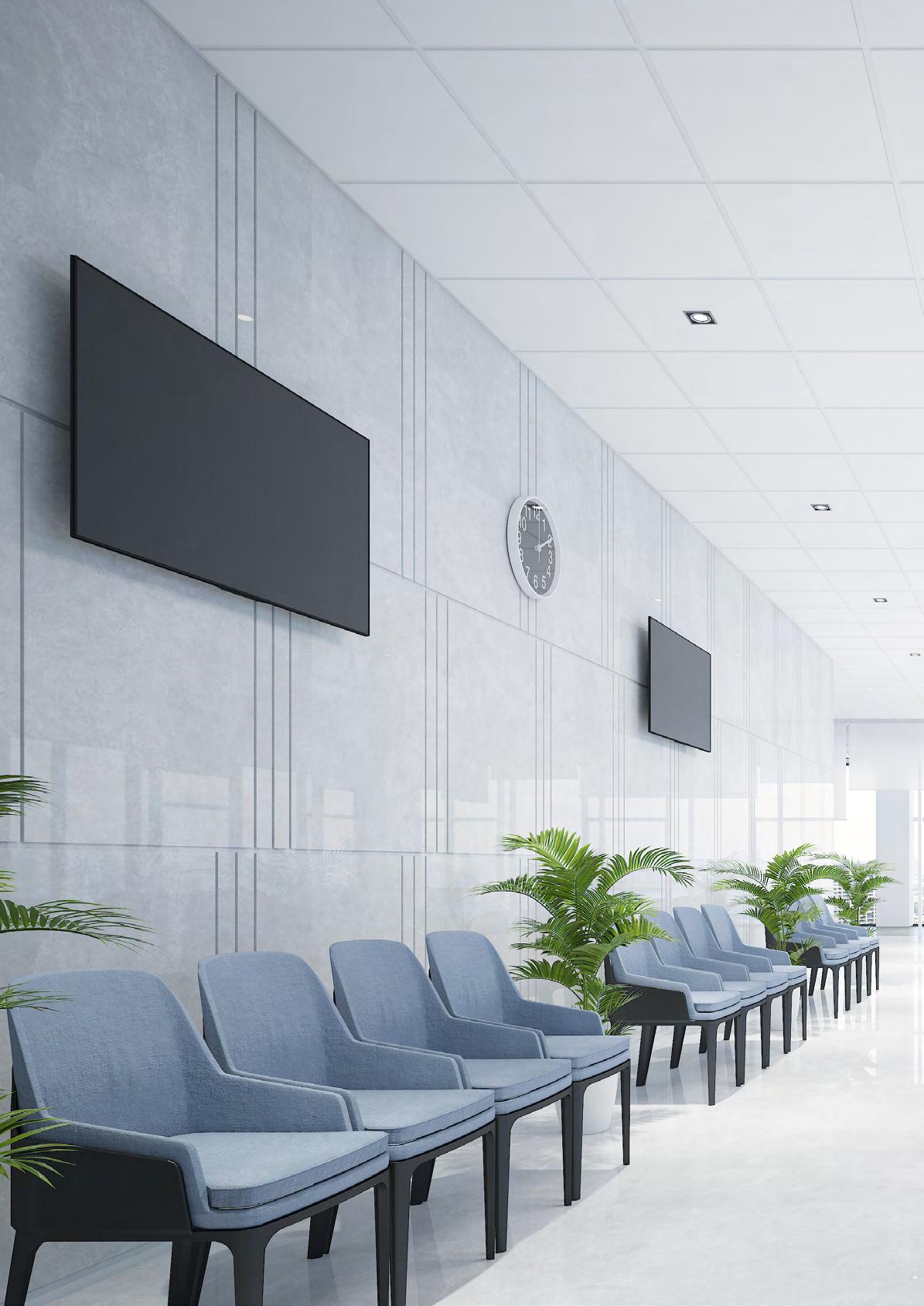





Panasonic has partnered with social housing provider, Together Housing, to deliver sustainable heating solutions to over 1,200 properties across the North of England. To date, Together Housing has switched hundreds of homes from gas boilers to Panasonic J Series Aquarea Monobloc air-to-water heat pumps. This year, the team is scheduled to retrofit a further 750 homes with many more to follow.
Panasonic is providing 5, 7 or 9 kW units to a range of 1 to 3 bedroom properties, primarily located in Yorkshire and Lancashire. Together Housing is one of the North’s largest social landlords, owning and managing over 39,000 homes. Working in collaboration for over two years, Together Housing and Panasonic’s shared net zero goals are the foundations for this partnership.
With a holistic approach, each home has an initial survey and ventilation assessment to check the home is suitable and if any additional insulation is required. This ensures that the homes gain maximum benefit from the energy efficiency of the Panasonic heat pump once installed.
Commenting on the advantages of switching to a Panasonic heat pump, one tenant, Eva, commented, “After only 6 weeks, I can already see a reduction in my energy bills.”
Another tenant, Shannon, spoke on the ease of fitting and operating the new heat pump. She said “The communication from the installers was very good as they kept me in the loop and explained each bit as they fitted it. When it was all finished, they showed me how to use it very clearly. The system is very easy to manage. There’s a Panasonic controller on the wall that has a timer, it’s much easier to set the temperature than my old gas boiler and the pump outside isn’t noisy at all.” Shannon recommends other residents have an air source heat pump fitted if it’s offered. She added, “I’ve already told my neighbours.”
Ensuring support throughout this transition period, Panasonic is working with Together Housing on an education initiative, ‘Go Green Together’, a portal
providing learning resources for residents. Guidebooks explaining energy bills, meter readings, available tariffs, smart meters, setting tenants’ heating, and financial support are available online. Tenant Liaison Officer’s (TLO’s) are on hand to help with any questions and support with the behavioural change required for the transition. All residents are offered a standard thermostat and programmer for easy-to-understand controllability of their heating system, in addition to the support team’s remote smart diagnostic tool.
Jose Alves, Regional Director for Panasonic UK, Ireland, and the Netherlands said, “Panasonic and Together Housing are setting the roadmap to net zero, but we are also building it as we go. As leaders in this commitment, we recognise the importance of a holistic approach to deliver energy efficient buildings and to provide residents with a collaborative solution for improved comfort and performance.”
Forward-thinking Executive Director of Property at Together Housing, Patrick Berry, initiated this approach, recognising the change that is required in housing to reduce carbon emissions from heating consumption. The project is entirely supported by a top-to-bottom system, with Board Members and Leadership alike determined to demonstrate the transformation this project can achieve to the entire housing sector.
Patrick Berry, said, “Moving towards energy efficient and greener social housing is vital to ensure we can provide a sustainable future for all our residents. As well as improving the energy performance of our existing housing stock and helping our most vulnerable residents to live in warmer, more comfortable homes, we’re also leading the way to deliver more environmentally friendly communities across the north of England. Panasonic’s support and response

to challenges has been second to none. We plan to share our lessons learnt with other housing associations so they can follow in our example.”
Delivery Manager at Together Housing, Gemma Voaden, added, “We are moving everything towards net zero as an everyday action, not simply a one-off principle, and Panasonic is helping make this transition much easier. The newly installed Panasonic heat pumps are providing evidence of healthy homes, with lower energy costs and proving to be more energy efficient when compared to other heat pumps available currently on the market.”
to improve efficiency
One of the biggest stumbling blocks preventing fast progression is the need to gain approval for heat pump installation from the area’s Distribution Network Operators (DNO). This process slows down installs not pre-approved on the DNO database. Together Housing has been lobbying the government to improve this process to ensure each installation can be delivered effectively. The Panasonic Aquarea J Series 5, 7 and 9kW are pre-approved for Connect & Notify, allowing for a faster and more straightforward installation process.
Panasonic Aquarea heat pump
The Panasonic J Series High Performance heat pump boasts an A+++ Energy Class, achieving average water outlet temperatures of 35°C and maximum output temperatures of 60°C. Bespoke software for maximum efficiency delivers low output temperatures. Panasonic cloud control and service with an easy-to-use remote controller for end user accessibility enables a holistic solution to heating. The Panasonic units are available in a range of sizes from 5, 7 and 9 kW, with an internal domestic hot water tank and external unit for ease of installation.
To find out more, please visit www.aircon.panasonic.eu/GB_en




In a bid to drive a greener future for prospective homeowners, the UK Government introduced the Future Homes Standard in 2019, which ensures newly built homes have low-carbon, energyefficient heating systems from 2025 onwards.
The heating and powering of buildings consumes 30% of the UK’s total energy use; therefore, it’s clear that homes play a significant role in the UK’s effort towards reducing energy consumption.
The shift in how we heat our homes from 2025
To meet the Government’s target of net-zero greenhouse emissions by 2050, our homes must become more sustainable. By implementing alternative energy systems and using recyclable materials like copper piping in heating, we can make strides towards increasing the longevity and versatility of our homes.
There are a range of low-carbon installations that developers and homeowners can embrace – including heat pumps, electric and biomass boilers, hybrid systems, solar water heating and insulation – to increase sustainability in homes while continuing to generate heat.
Copper’s role in low-carbon heating systems
As an excellent conductor of heat, copper allows for rapid and efficient heat transfer, making it the standout choice for supplying the heat generated by low-carbon heating systems.
Copper pipes can be integrated with air-source heat pumps, transporting the heat extracted from outside air to radiators, electric heaters and other outlets. As well as improving efficiency, copper pipes are also infinitely recyclable, helping to reduce carbon emissions associated with the design of air-source heat pumps.
Copper is also the driving force in solar thermal panels and other water heaters, which harness the sun’s energy to warm homes. Copper piping is useful here due to its ability to withstand high temperatures and pressures over alternative plastic materials, such as multilayer composite (MLCP), polyvinyl chloride (PVC) and polyethylene (PEX), which have a low melting point and can crack easily.
The integration of infinitely recyclable materials like copper piping into our homes will play a transformative role in the future sustainability of the residential sector. With a typical life expectancy between 70 and 80 years, copper possesses reliability over materials like plastic, retaining up to 95% of its value over time.
With low-carbon heating systems being phased into homes from 2025, infinitely recyclable materials like copper have a significant role to play in sustainability improvements.
To find out more about the recyclability of copper, visit: www.cuspuk.com




In 2014 FUTURE Designs developed a specific fluorescent lighting system for installation in this iconic office space. This was one of the final major projects where FUTURE Designs provided fluorescent lighting prior to the advent of solid state LED becoming the lighting medium of choice.
The Client’s decision to invest in the latest sustainable technology (LED) and product reuse which not only hugely reduces the energy (carbon) use within the premises but reduces the extraction from the earth’s crust.
FUTURE Designs have succeeded in winning the contract to adapt circa 6000 previously supplied luminaires to latest generation LED under their carbon careful™ initiative utilising the existing luminaire carcass.
The energy and carbon savings in the adaptions are circa 61% compared to the original fluorescent lighting system and additionally the reuse of the existing luminaire carcasses will save 7.9 tons of mild steel being produced with an immeasurable quantity of carbon saving from extracting precious minerals from the earth’s crust. See video here.
This project takes the total of office space reilluminated under the carbon careful™ initiative to over 4 million sqft to date.

International Timber, the UK’s leading importer and distributor of bespoke, sustainable timber and panel products, has collaborated with specialist joinery manufacturers Runciman & Redpath on internal modifications to homes across Scotland, providing high-quality timber to be used for staircases and bespoke benches.
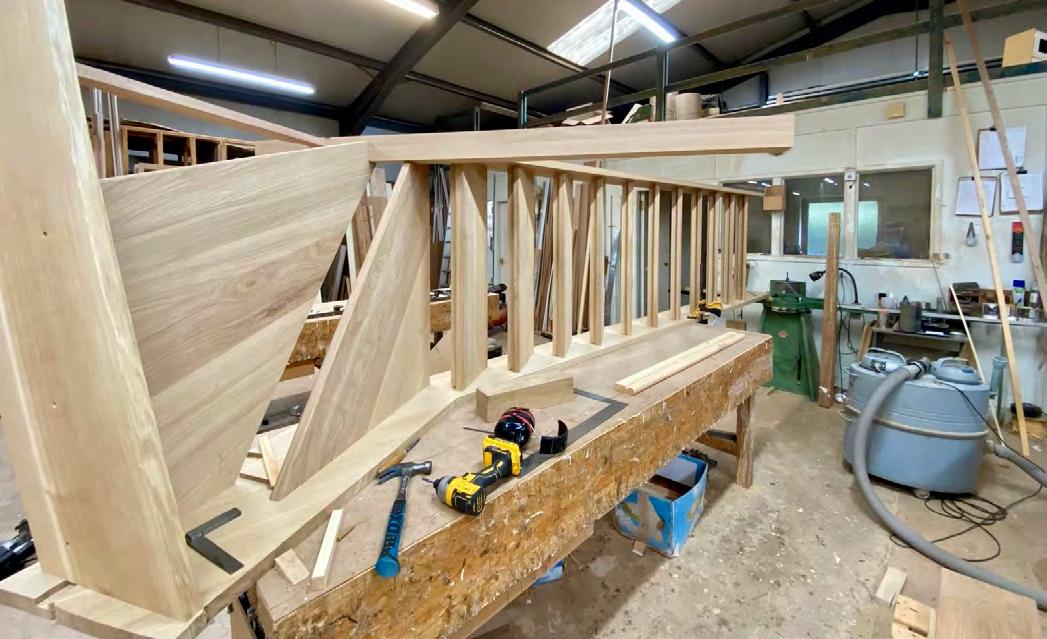
Runciman & Redpath is a specialist joinery manufacturer who undertake interior renovation projects across Scotland, creating bespoke features from timber. Having recently completed five stunning projects, the team have worked alongside International Timber to provide staircases, benches, shelving and panelling for large estates and new build properties.
Working together for over a decade, Runciman & Redpath utilised Laminated Oak supplied by International Timber for the construction of its joinery projects. The strong relationship between both companies has resulted in high-quality home interior improvements to be achieved as well as the mutual sharing of expert advice within the timber and joinery industry.
Laminated Oak is a type of engineered timber that consists of layers of wood veneers glued together to create a strong and durable material. It provides huge benefits, such as strength, durability and design flexibility.
With the high traffic volume that stairs and benches experience, Laminated Oak’s strong and flexible qualities make it the perfect material for any such projects. One of the key advantages of Laminated Oak is its flexibility; the layers of wood veneers can be bonded together in different directions, making it the ideal material for use in curved structures or traditionally difficult, uneven surfaces.
This flexibility also means Laminated Oak can be cut and shaped to fit any design, giving architects, designers and joiners greater creative freedom to create innovative and bespoke designs.
Initially, one of the main challenges for Runciman & Redpath was choosing a timber product that would create a consistent colour to ensure its clients’ desired aesthetic was achieved when manufactured into staircases, benches, shelves and panelling.
International Timber chose to supply American White Laminated Oak to create a consistent wood effect across the internal modifications of each home. Laminated timber is just as aesthetically pleasing as solid wood, and is a great alternative for exposed beams, shelving and panelling interiors compared to steel or concrete.

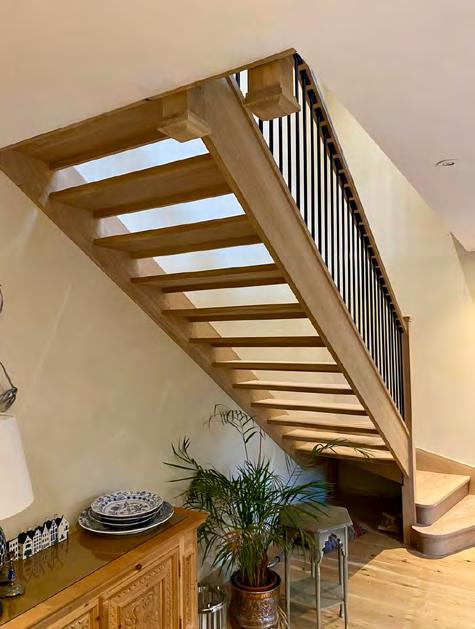
Kevin Anderton, Senior External Sales Representative at International Timber, said: “It was great to work with our longstanding customer Runciman & Redpath on these projects, continuing our strong working partnership. The team continues to buy from International Timber based on the added value services that we offer.”
Ewan Redpath, Managing Director at Runciman & Redpath, said: “International Timber provide an excellent and reliable service for each and every job. I have been working alongside Kevin for over 10 years and he always provides expert advice regarding the recommended timber solution for any joinery project.”
International Timber is a leading specialist in laminated and modified timber products, including a variety of different options that are suitable for a whole host of projects. For more information, visit
www.internationaltimber.com
Taking place Friday 27th of September at the Novotel London West, the awards will be hosted by comedian, actor, and presenter Tom Davis. The London Construction Awards celebrates the major achievements, developments, and innovations that have shaped the UK’s booming construction landscape over the past year.
The entries will be judged by an independent panel of industry leaders from all across the AEC industry, with the winners announced at the glittering gala dinner this September.

London Construction Awards 2024 Finalists: Apprenticeship Initiative of the Year
• Berkeley Group
• ESG
• Mates in Mind
• On The Tools
• UK Power Networks
Architectural Design of the Year
• Carey Jones Chapman Tolcher - Hove Gardens
• Foster + Partners - Apple Battersea
• Foster + Partners - Battersea Roof Gardens & Fifty Electric Boulevard
• Glenn Cavill Architecture - The Shippon
• Holland Harvey and GAIL’s Bakery
• Studio Arkell Ltd - Shearwater
• Windsor Patania Architectures - XR Lab, Anglia Ruskin University
Commercial Project of the Year
• AIS - Stellar
• Casia Robinson - Enigma Pan-Asia and Grill
• Equans
• GAIL’s Bakery
• Haworth Tompkins
• L&P Group
• Lorenc Design - Providence Equity Partners
• OMO & Focus
• Quadrum Global - 11 Belgrave
• ReCreation & Piperhill - Rainham Leisure Centre
• Rolfe Judd - 33 Kingsway
• Skanska UK & British Land - Norton Folgate
Construction Software of the Year
• 4PS Construct
• AIFORSITE - Wendy
• ALICE Technologies
• Buildots
• DMRC Technologies - allo
• Ethical Power Connections - Smartsheet
• Foresight
• GRAHAM - CORA
• Houzz - Houzz Pro
• innDex
• Lattice Build Technology
• Lbox Communications - tellthem
• LiveCosts
• PlanRadar
Consultant of the Year
• Arcadis
• Deecon Consulting
• Graham Kinnear Property Consultant
• Harley Haddow
• Procur3d Consulting
• Quartz Project Services
Contractor of the Year
• Abbey Extensions & Renovations
• Advance Facilities Group
• Kilnbridge
• SB3 JV
• T&T Facades
• Twenty Four Hour Engineering
• United Living Property Services
Digital Construction Team of the Year
• AICHITECT
• Chetwoods
• John Sisk and Son
• ODGroup
Diversity & Inclusion Initiative of the Year
• Balfour Beatty
• Balfour Beatty VINCI SYSTRA
• Building Heroes
• Chartered Surveyors Training Trust
• Cisco Systems
• Cosy Hauz
• Danny Sullivan Group
• Direct Access Consultancy
• Gensler
• Mentoring Circle
• Morrison Design
• Skanska Costain Strabag Joint Venture / SCS Railways
• Transport for London
Excellence in Community Engagement
• 2-3 Degrees, Landsec & B|D Landscape Architects
• Align JV
• Barnet Council
• British Land - Norton Folgate Project Charter
• Curl la Tourelle Head Architecture - Your Bruce Grove
• Danny Sullivan Group
• KBH Haus
• Multiplex Construction Europe
• Olli Group
• Poplar HARCA
• Quinn London
• Reliable Contractors
• Residential Energy Services
• TSG
• Willmott Dixon - Gascoigne East Estate Regeneration
Excellence in Sustainability - Product
• 540 World
• Amorim Cork Composites - Acousticork by Amorim U38
• Demand Logic
• Dumarey Green Power
• Earth4Earth
• eLstar Dynamics
• GAIL’s Bakery & Shoplight
• Gentian
• HAHN Plastics
• Madaster UK
• Roseview Windows - ThermoVFlex
• Sapphire Balconies
• The Bike Storage Company
• Troldtekt
• YardLink
Excellence in Sustainability - Project
• Bouygues UK & Westminster City Council - Ebury Bridge Estate
• Chetwood Architects and Baytree Logistics Properties - Baytree Nuneaton
• CNG Fuels
• Connor Ferris Architects - Eco5 Home Development
• Eight Versa and Molyneux Architects - Elmara Passive House Plus
• FM Conway & Westminster City Council - Elmfield Way
• GRAHAM - Reardon Court
• Knightsbridge Development Corporation
• Low Carbon Materials - County Durham Net Zero Asphalt Scheme
• McAleer & Rushe - Canada Water
• ODGroup - The Avebury
• Osborn Associates - Spelthorne Leisure Centre
• Quadrum Global - 11 Belgrave
• RDM Electrical & Mechanical Services - Cross Hands East
• Woodalls Design - Axa Workplace
Fire Safety Solution of the Year
• CLM Fireproofing
• Eurotech Fire Systems
• Fire Door Maintenance
• Fire Protection Association
• Fire Stop Products
• Hyfire Wireless Fire Solutions
• MyDek
• PlanRadar
• Ramtech
• Securo
• T&T Facades
Marketing Team of the Year
• Aggreko
• BM Steel
• Ecosafe Group
• Eleven
• Guardtech Group
• Inner City Scaffolding
• On The Tools
• UAP Ltd
Click here to view the complete list of finalists
Congratulations to all who are shortlisted! Now it’s time to book your tickets and get ready to celebrate. Good luck, and see you at the ceremony on September 27th, at the Novotel London West.
For more information and to buy tickets, please visit: www.londonconstructionawards.com
Jess Fox is a seasoned software professional with over 23 years of experience in delivering she has been an integral part of the development team for the Asta suite of products overseeing the Asta brand. Jess excels in uniting teams, problem solving and bridging her strong belief in servant leadership. Outside of her professional life, Jess is a musician Shropshire with her youngest daughter and their German Shepherd, Lilah.
Can you tell us a little about yourself and your background?
I grew up very humbly and we moved around a lot because of my Dad’s job, including stints in the US and 4 years in Kenya. I think these experiences gave me an older head and despite flying through school, I decided not to go to university. Instead, at 18 I got the first job I could get in a call centre – and amazingly, this decision later led to a career in software.
What inspired you to pursue a career in this industry?
Probably like many people, I didn’t aim for Contech, or even tech at all. I fell in to the world of software after being seconded from an admin role to help test some new systems. Immediately I had an aptitude for the analytical problem solving that was needed and I excelled at it. That particular company actually created a job in the Development department especially for me. After being made redundant, I took a job in what was then a reasonably small, local software development team called Asta Development and the rest is history.
What do you consider to be your biggest achievement so far?
Definitely the creation of Asta Vision. My colleague, Chris Ray, had come up with an idea to solve a problem for a particularly large US customer who needed a way to manage thousands of projects. From that
idea, we wrote a bespoke, on-prem solution for them to manage and control their planning process and files.
We knew we were on to something, but we didn’t have enough to build something generic. I travelled around and met up with a number of our larger customers. I asked them about their pain points and problems and got told stories of losing contract baselines and not knowing which file was the latest one.
I took all this information back to our amazing dev team, and together we designed and wrote what is now Asta Vision. The product continues to grow and improve and I am incredibly proud to have had ownership of such a game-changing product from day one.
What are some of the challenges you’ve faced in your construction career, and how did you overcome them?
In software, we face challenges constantly. We are always negotiating that triangle of scope, time and resources. Something almost always has to give, and you have to compromise..
However, we pride ourselves on being close and listening to our user base and always trying to help solve their problems. This, for me, requires pragmatism.. Sometimes you just have to take a step back and be pragmatic about whatever it is that’s in front of you.
delivering high-quality software solutions. For the past 19 years, products and currently serves as the Head of R&D at Elecosoft UK Ltd, bridging the gap between users and developers, underpinned by musician at heart and a dedicated mother of three. She resides in
Can you describe a typical day in your role?
I have regular meetings with the dev and test teams, to look at the current active work –where we are, what we’re doing. The Product Manager and I may then sit down and look at roadmaps and plans, or go through and review incoming customer requests. I write a lot of our requirements documents for features we implement, so there is often that to do.
Later, there will likely be a 1-2-1 with a member of my team. Elecosoft has been awarded a Great Place to Work Award for the third year running and a big part of the reason for that is because of the people. We have so many great people at Elecosoft, who care deeply about what they do and take pride in their work. I honestly feel privileged to work with such great people.
The rest of the day might involve customer meetings to solve a technical problem or discuss a new feature, or a conversation with a stakeholder in the business to ensure we’re aligned on things. There is always plenty of variety.
What advice would you give to someone aspiring to enter the world of con-tech?
It’s a tricky one because I never set out to be in this world, but funnily enough, I now feel more part of Contech than I do standard “tech” if that makes any sense. I’ve worked in banking and life assurance software previously, and the fun part about being involved in Contech is you feel part of something bigger, and when one of our

customers completes a great big new stadium, or record-beating bridge, you feel a part of that. It’s a great industry to be a part of.
Can you shed any light as to what Eleco is working on next?
In the Asta Powerproject world, we are working hard right now on improving our 4D offering with a new graphics engine and streamlined workflows to really bring more power to our users’ hands and make their lives easier.
We’re also investing in AI and Machine Learning. We recently introduced AstaGPT to the market, which is our innovative AI help system nominated for Best Product Innovation at the Digital Construction Awards. The exciting thing for us is that in partnership with our customers, we have access to a wealth of planning data. Combining this with our capabilities and experience, we can help organisations make sense of that data and harness it to drive more efficient processes and lock-in reliable outcomes. It’s creating certainty for the built environment, which is what we’re all about!
www.elecosoft.com
Workspace Design Show continues to innovate, expanding its diverse portfolio of exhibitors for the London and Amsterdam 2025 shows, and will feature Umbrella Furniture as the lead partner for the talks areas at the 2025 London edition, designed by Gensler and Ryder Architecture.

Launched in 2021, Workspace Design Show is a firmly established highlight of the global workplace event calendar. Bringing together world-class design and manufacturing industry excellence, the 2025 editions, which take place in London (26 - 27 Feb) and Amsterdam (5 - 6 Nov), feature a stunning line-up of brands, including König + Neurath, Ahrend, Interface, Tarkett, Kettal, Bisley, and Interstuhl.
With 65% of the floorplan sold out with a little over eight months until showtime, brands at the London Show include Swiss design heritage brand USM, global office furniture manufacturer Spacestor, leading contract furniture manufacturer Brunner, renowned Spanish brand Expormin and British manufacturer, Bisley, who has recently launched three new shades to complement their
existing colour range of 37 finishes; a demonstration of their evolving diversity and commitment to offering choice.
As a platform leader in design knowledge exchange, Workspace Design Show is working with select industry leaders to form an exemplary expert advisory group. Bringing unique knowledge and expertise, the panel consists of Clare Bacchus, Global Lead at The Design House, Barclays; Collin Burry, Design Principal at Gensler; Allison English, Deputy CEO at Leesman; Gurvinder Khurana, Director at M Moser Associates; Matt Jackson, CEO at BDG architecture + design; Mark Simpson, Principal and Board Director at BDP; Dharshini Singh; Neil Usher, VP Places at Sage; and, Dominic Williams, Interior Director, Ryder Interiors.
Workspace Design Show in London 2024 welcomed over 4,500 workplace professionals from over 40 countries at the Business Design Centre between 27-28 February. Attendees explored the latest trends in office specification from furniture, lighting, flooring, and more, totalling over 500 different products.
Esha & Charlie Bark-Jones, Workspace Design Show founders, said, ‘We are proud to work with such an exemplary community of international design brands and industry experts across both our London and Amsterdam shows. Providing a world-class platform that brings industry experts together to exchange knowledge and connect, with the goal of transforming the employee experience in our workplaces. We are excited to see the 2025 content developing so well with such amazing partners and design content—watch this space!’

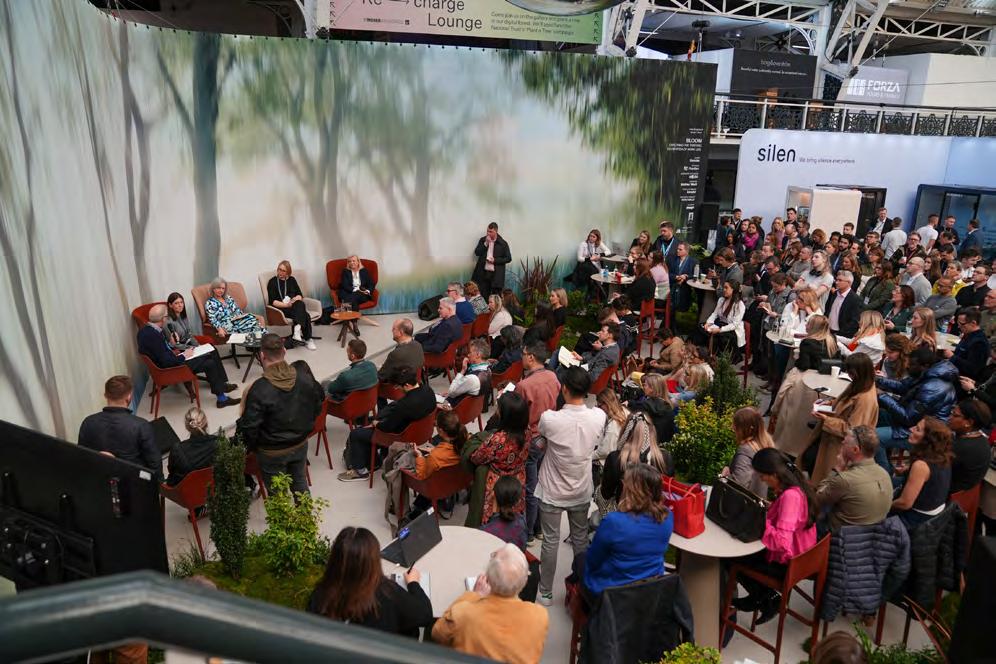
Leading construction firm
Thomas & Adamson (T&A) has helped one of the country’s best known energy providers step further into a greener future by delivering a sustainable workplace project that forms its new co-located Scottish headquarters.
The £6M Cat A fit-out at OVO’s Scottish offices in the heart of Glasgow is expected to achieve BREEAM Excellent accreditation, highlighting OVO’s commitment to the environment. The new space, spread across three floors and covering 33,905 sq. ft, is located within Cadworks, Scotland’s first Net Zero Carbon operational office building.
T&A provided project management and cost management services for the new facility alongside Linear Design & Construct, Michael Laird Architects, Wallace Whittle and Woolgar Hunter Engineers. To support OVO’s commitment to achieving net-zero emissions by 2035, sustainable building products and systems were used throughout,
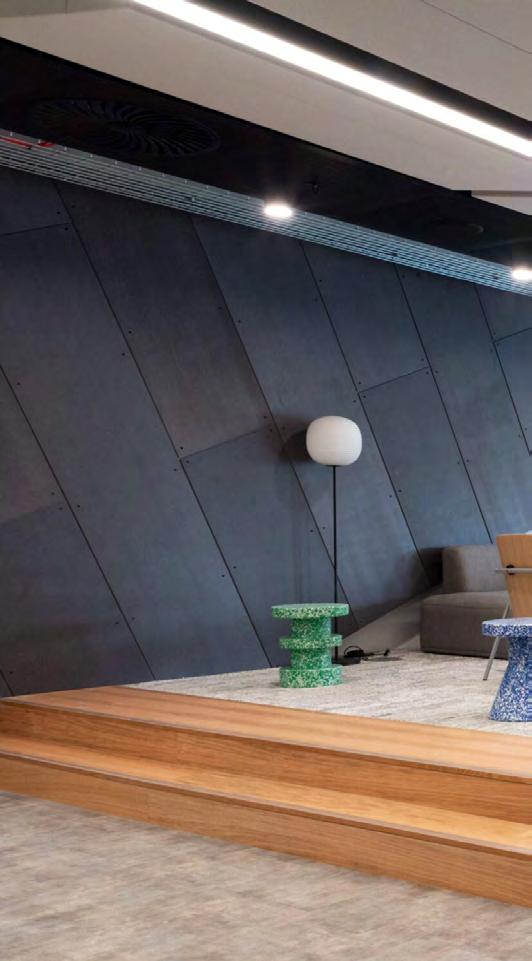
creating a vibrant and collaborative workplace.
Paul Mackintosh, Regional Director at Thomas & Adamson, said: “Projects such as OVO’s Scottish headquarters are a pleasure to work on. It allows us to showcase our ESG credentials and range of services, whilst collaborating with both a client who has a real vision of what they require, as well as worldleading design and engineering teams.
“OVO’s new premises offers the best-in-class environmentally aware workspace and is a welcome boost to the city.”

George Waite, Head of Property at OVO, said:
“A big thankyou to the team at T&A for helping to successfully deliver our new home in Scotland. They have worked tirelessly and collaboratively to keep the project on track and on budget. Under T&A’s stewardship the wider project team have worked really well together to overcome challenges and changes along the way. We are extremely happy with our new office and the feedback from our people has been phenomenal.”
The OVO fit-out completion comes as Thomas & Adamson begins work on another Cat A fit-out for
the global energy business EDP at Exchange Crescent in central Edinburgh. T&A are providing project management, cost management and Principal Designer services on the project, which is due for completion mid-2024.

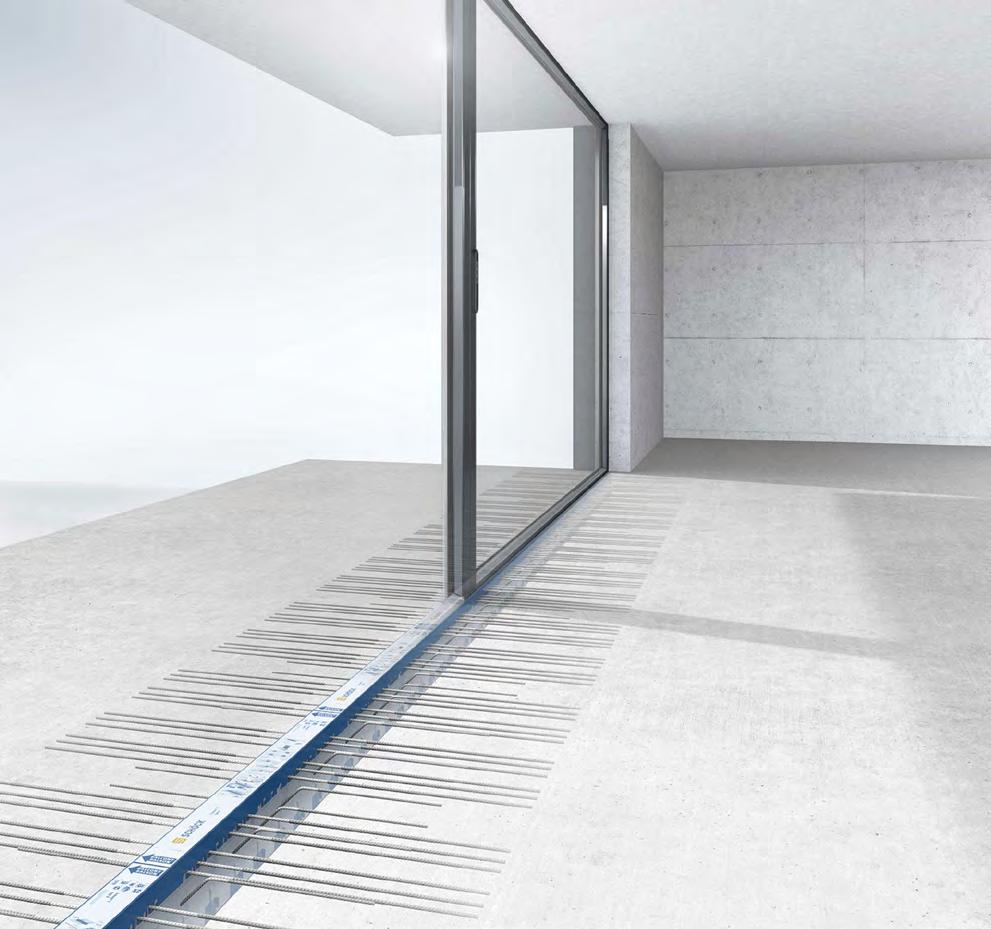
A new Chiswick Health Centre is being built in Fishers Lane, West London. This is an NHS upgrade on the site of the previous building. The new facility, designed by architect Allies and Morrison and under construction with Willmott Dixon, will be a key hub for 60,000 patients and provide GP consulting and examination rooms, district nurse facilities and community rooms. In a separate but associated building, sited around a landscaped central courtyard, the project will also deliver 55 affordable homes for key health workers such as nurses and physiotherapists. Balconies inevitably feature throughout the accommodation areas and to avoid any risk of thermal bridging at the various connectivity points, the design detailing required a structural thermal break with total reliability proven performance.
Specification required standard and bespoke Isokorb solutions
At the low and intermediate levels of the structure, the choice was the Schöck Isokorb T type K for concrete-to-concrete. It is probably the best-selling European thermal break solution for this type of application and is manufactured using stainless steel and HTE (High Thermal Efficiency) modules with steel fibre reinforced UHPC (Ultra High-Performance Concrete). This guarantees the highest

quality thermal separation of balconies and floor slabs, due to its low thermal conductivity and integral load-bearing capacity. At the top of the building, bespoke Isokorb units had to be provided for the roof level colonnade beams, which needed to be thermally broken. These ‘specials’ involved thermal break units with point shear-load capacity for restricted wall-over and wall-under conditions, fitting within a narrow RC ring-beam feature.
Due to differential thermal movement between internal and external slabs in the walkways on the project, Schöck have also provided structural steel dowels to transfer loads over the joints.
Schöck offers the widest range of structural thermal break solutions from any European supplier and in the UK enables projects to meet full compliance with the necessary Building Regulations (and the impending Future Homes Standard criteria where relevant). In addition to the Isokorb type used on this project, there are also solutions for concrete-tosteel, steel-to-steel, renovation projects – and even a maintenance free alternative to wrapped parapets. All products have the security of independent BBA Certification, which provides NHBC approval. The

temperature factor requirement (fRSI) used to indicate condensation risk, which must be equal to, or greater than 0.75 for residential buildings, is also easily met by incorporating the Isokorb.

Contact Schöck on 01865 290 890; or for full details of the Isokorb range of solutions visit: www.schoeck.com/en-gb/isokorb

The AR75 is physically larger at 730 x 730 x 300h and provides over 4kW of sensible cooling. Both products use the same industry-leading low energy design revolutionised by Artus Air, enabled by a fully variable speed fan with specific fan powers as low as 0.05 W/l/s. All of this is achieved under the same noise conditions as the existing AR60 units.
The AR75 is available in two and four pipe variants and can provide heating and cooling separately, or heating and cooling with electric heating optional, if required. Like the smaller AR60, the AR75 is fitted with a coil, air filters, condensate pump, BMS controller and Pressure Independent Control (PICV) valves which are pre-wired for a plug-and-play ease of use. BMS connections are by BACnet MSTP or BACnet IP, with standard and enhanced controller options.
Artus Air, the company revolutionising heating and cooling air conditioning, has today added its AR75 model to its range. The new larger unit has been launched to meet customer demand and represents a significant milestone in Artus’ strategic development strategy. Together with the AR60, the AR75 is being targeted at the commercial office, retail, industrial and hotel development and retrofit markets. They offer a significant reduction in operational energy consumption and carbon emissions when compared to industry standards. The AR60 has already delivered 1000tCO2e carbon saving and 4.7ys installation saving. With the greater flexbility afforded by the two products these savings will accelerate.

The two products give building designers the choice of two sizes to best meet the needs of CAT A to B fit outs. The AR60 is perfect for small cellular offices, and projects with restricted head heights. The larger AR75 can serve typically 40 sqm or more of open plan office.
The system has the option of internally mounted isolation valves, a flushing bypass, flow measuring device and drain and air vents on the majority of models. This will reduce programme time and costs. Artus believes that incorporating these features inside its products is an industry first.
Ed Sayce, Sales Director of Artus Air comments:
“This is a hugely exciting milestone delivered by our strategic development program. Demand from the construction industry for a system of this size and capacity has been significant since we brought the AR60 to market and we already have a strong pipeline of interest.

“If the construction and development industries are to meet 2050 net zero targets innovation in design is essential – the AR75 hand in hand with the AR60 unit can support this and we are excited to see the impact it will have.”
Roger Olsen, CTO and inventor of Artus Air comments:

“Our development strategy is based on carefully thought out, highly refined and innovative products in two main product families. They are tailored to meet customer requests, and factor in the growing requirements of heat pumps and low energy cooling sources.
The units minimise both operational and embodied carbon to meet needs of our customers while remaining committed to our core business purpose of addressing sustainability necessities in our industry.” artusair.com
The demand for firewood has seen a noticeable growth in recent years, with sales increasing by as much as 20 to 25% in 2022, according to industry experts. This can be for anything from wood-burning stoves to firepits and shows how popular home burning has become. However, many may not know what wood is best for burning sustainably and efficiently.
Stephen Talbot, sales director of Logs Direct, one of the leading suppliers of kiln-dried firewood in the UK, has provided this guide into the best woods for home burning for the perfect blend of heat output and long burning. This way, you can make informed and knowledgeable decisions on the woods you’re buying.
The basics of hardwoods vs softwoods
When learning about different types of wood, the first big lesson is the difference between hardwood and softwood. Some common examples of hardwoods are oak, beech, and ash, and they’re characterised by their denser structure, which causes them to burn more slowly. This means that their heat output lasts longer and provides more consistent heat.
Softwoods, meanwhile, are better for kindling, as they ignite easier and burn faster than hardwoods, such as pine or spruce. This is why when you’re building an efficient fire, using a mix of both styles of wood is best for getting it started burning and then maintaining it. Use softwoods as a base for kindling and catching light, and then stack hardwoods on top in a teepee position to ensure they light properly.

While wood you can buy from your chosen supplier means it’ll be dried, it’s important to note that you shouldn’t burn any wood you have or even find. For the most efficient burning and avoiding a surplus of smoke

that can cause a buildup of soot and creosote in your chimney, it’s best to use wood that has a moisture content of between 10 and 20%.
If you were to establish the standard bearer among hardwoods, few come close to oak. Slow burning with a high heat output (but only if you have a good draw on your fire), it’s an ideal choice to warm through a living room from a wood-burning stove or a group around a firepit. It takes longer to season than other woods, but it’s more than worth it. It is a reliable source of fuel for home fires.
Another hardwood for a consistent and steady heat output is beech, which benefits from not as much crackling or popping as others. It’s also a wood that results in less creosote buildup than other choice hardwoods, meaning less of a chimney fire risk. For those looking for an efficient wood with less fireplace cleanup, beech might be the wood for you.
For veteran log burners who may prefer to break down and season their wood, ash is a fantastic choice. It splits well and is incredibly fast seasoning, and once burning, it offers a steady flame with consistent output. It’s also available seasoned like other hardwoods on this list and is just as practical as the version you season yourself.
Birch wood, or other members of the birch family like alder wood, are perfect for a quick fire. They catch quickly and give you lots of pleasant dancing flames with plenty of heat to get the fire going, but it won’t last anywhere as long as harder woods.
But in Britain today, birch and alder have proved to be favourites for the pizza oven. Whether it’s for a commercial operation or domestic pizza oven party they can give you the speed of lighting with the length of flame to the middle of the dome and heat to get the pizza cooked perfectly.
It’s not just about the heat output or how quickly the wood burns, but considering the sustainability of your chosen fuel is an important factor. Buying firewood that’s been locally sourced cuts down on emissions from transporting it and helps sustain local businesses. Plus, to ensure that it’s coming from forests that are being maintained and overseen responsibly, look for certification from the Forest Stewardship Council (FSC)
Finding the right balance between your use of softwoods and hardwoods builds the best home-burning fire. On top of this guide, it’s important to correctly store your fuel so that it’s not tainted by weather conditions that you can’t control, leading to the moisture content rising or any moss or mould forming. This can be done by storing it in a cool, dry area or even building a log shed to keep it covered.
An opportunity to be bold
From addressing the housing shortage to reigniting enthusiasm and attracting investment in our inadequate infrastructure, the government has an opportunity to be bold and produce a budget that addresses the needs of its people, while prioritising economic growth.
This is even more important in light of recent news that UK GDP was down 0.3% in 4Q 2023 and that the economy went into recession. Construction performed the worst out of all sectors. All eyes will be on the government to see what difference, if any, they could make.
We continue to call for clarity on infrastructure
Construction investment is a lever of growth, given the multiplier effect. At the end of last year construction activity went into negative territory, with a 1.3% decrease in 4Q 2023, driven by significant falls in both housing and infrastructure output. Therefore, it’s vital the chancellor introduces some measures that will stimulate the economy and give the industry renewed hope and optimism.
We have continually called for ‘clarity and consistency of policy and regulation’ in the government’s approach to overseeing infrastructure investment and its delivery. As the recent publication of the long-awaited Infrastructure Pipeline showed current plans are patchy and inadequate.
It failed to nail down the detail that would give more certainty to a sector still reeling from the repercussions of costly financing, budget erosion and super inflation.
An action plan for investment that will stimulate growth across energy, water, transport and communications is essential.
This should include the recommendations, as set out by the National Infrastructure Commission: investing in public transport; improving underperforming parts of the national road network; developing a long-term rail plan; reducing the number of properties at risk of flooding; adding low carbon technologies to the electricity system, to create a new strategic energy reserve.
It’s been a year since the Shortage Occupation List

(SOL) was introduced to help resolve labour issues in construction. But we’re yet to see if the additions to the list six months ago concerning the extra construction roles can make a difference.
Meanwhile, the government still lacks a clear strategy for ensuring we have the additional 224,900 workers required to meet UK construction output between 2023 and 2027, especially the green-collar workforce we so desperately need to help the UK achieve its net zero targets.
The government could give a much-needed boost to housing by investing in a significant programme of social housing as a part of a wider joined-up housing policy.
From safeguarding vulnerable residents in social housing to ensuring our schools and hospitals are habitable, we also ask that the government prioritises vital repair and maintenance (R&M) work, across the public and private sectors.
We continue to advocate for the mandatory reporting of whole life embodied carbon, as the missing vital step towards decarbonisation.
And although we’re encouraged to see the government invest in improving energy efficiency in homes and buildings, through the allocation of funds that include the Social Housing Decarbonisation Fund, operational carbon is just one part of the picture.
A recent report, Carbon Blind Spots, from the MMC (Modern Methods of Construction) consultant Akerlof, has found that Scope 3 emissions (embodied carbon) are responsible for an enormous 94-98% of emissions from the UK’s top contractors.
The government needs to support the industry in its efforts to reduce carbon emissions in the built environment, through incentivising data sharing and subsidising the costs that manufacturers incur to produce verified Environmental Product Declarations (EPDs) on their materials and components.

Isuzu trucks are robust and adaptable enough to suit any number of different applications.
The 3.5T Grafter chassis cab is available with either single or twin rear wheels. The standard ‘Driveaway’ vehicle body options include Dropside, Tipper and Utilitruck.
www.isuzutruck.co.uk
Trusted by generations of architects and installers, Aruba is specified throughout the UK almost every single day. With impressive sound properties, and a range of colours available it is an incredibly versatile range that can be found everywhere from hotels and offices to classrooms and retail environments.

The range has been named after the white sandy beaches of the Caribbean due to the finely sanded finish of the tile’s surface. The Aruba tile also reflects the vibrancy and colourful nature of the Caribbean, as it is available in 35 colours, the largest option of standard colours available on the UK market. For further design creativity, the Aruba family can be specified in alternative shapes such as the Aruba Triangle.
Additional tiles with enhanced performances are available within the Aruba family including Aruba hH, Aruba Max and Aruba dB, each bringing unique performance capabilities.

The Aruba tile is incredibly versatile, with a number of attributes that deliver a thorough solution. Combining Class C sound absorption with a sound attenuation level of 34dB, the tile controls background noise levels whilst allowing sound to travel, creating an acoustically comfortable setting. It contains up to 44% recycled content, is 100% recyclable and is scratch resistant.
Recently specified for an industrial site in one of the UK’s most important manufacturing areas, the coloured Aruba tile was able to meet the aesthetic, functional and acoustic requirements set out for the project. Ceiling installer, Barry Deane, Director at East Midlands Ceilings commented on the Aruba family: “It’s always exciting when the customer

wants a change from the standard types of suspended ceiling designs. It made the project extremely interesting to be involved with, and the Aruba coloured tiles look amazing, giving a modern and visual twist over the standard install. The quality of the materials was also fantastic, with everything being manufactured and delivered to suit the project requirements perfectly.”
Aruba hH
The Aruba hH tile offers enhanced high humidity resistance, making it ideal for areas such as changing rooms. It also has the same acoustic qualities as the Aruba tile; but can remain stable in conditions of up to 99% Relative Humidity (RH).
Aruba Max
The Aruba Max is a more robust variation of the standard Aruba tile, designed for interiors that require a higher technical performance. With an increased tile thickness, it offers higher sound attenuation levels of 35dB, and is perfect for settings such as classrooms where sound still has to travel but in a controlled manner.
Aruba dB
For internal settings that require extra levels of privacy such as meeting rooms and small offices, the Aruba dB tile offers the highest sound absorption rating at 39dB and reduces sound transmission through the ceiling void.
